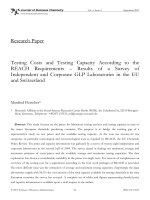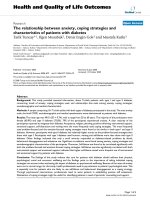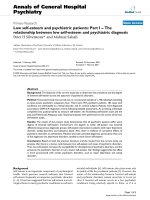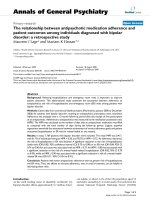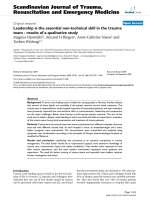THE RELATIONSHIP BETWEEN STUDENTS’ INTRINSIC MOTIVATION AND THE FINAL EXAM RESULTS OF A STUDENT ON ENGLISH SUBJECT
Bạn đang xem bản rút gọn của tài liệu. Xem và tải ngay bản đầy đủ của tài liệu tại đây (1.1 MB, 10 trang )
<span class='text_page_counter'>(1)</span><div class='page_container' data-page=1>
THE RELATIONSHIP BETWEEN STUDENTS’ INTRINSIC MOTIVATION
AND THE FINAL EXAM RESULTS OF A STUDENT ON ENGLISH SUBJECT
VO MAI DO QUYEN
Faculty of Foreign Languages, Hanoi University of Industry
Abstract
This study investigated the relationship between intrinsic motivation and the final exam results of students
of English subject at Industrial University of Ho Chi Minh City (IUH). Respondents in the study were
200 students (N= 200) who study at the Faculty of Technology, and Economics. They were selected
through random sampling from a total population of 1500 students at IUH. A survey questionnaire
composed of 11 questions were used to gather data. The questionnaires were sent to 200 respondents who
in turn answered and returned, yielding at 100 % response rate. The collected data were analyzed by using
the following statistical tests on (SPSS: Statistical Product and Services Solutions): The one-way analysis
of variance (ANOVA), and T- test for paired samples [1], [2]. The results showed that there were no
significant differences between intrinsic motivation and demographic variables, and no significant
differences were found on students‘ intrinsic motivation and overall motivation. At the end of this study,
some recommendations and suggestions for further studies were stated.
Keywords: Intrinsic motivation, final exam result, student of English subject, Industry University of Ho
Chi Minh City (IUH).
1. INTRODUCTION
There are many factors affecting students' learning outcomes such as: Attitude of the Students, School
Resources, Leadership Aspects, Skills and Abilities of the Teachers, Classroom Environment, Role of
Parents, Motivating and Encouraging Students, Teaching-Learning Methods… [3]. Motivation is central
to human activity and is related to satisfaction of needs and desire. Advanced Learners‘ Dictionary
considers ―to motivate‖ as ―to be the reason for somebody‘s action, to cause someone to want to do
something‖. Moreover, motivate means to provide with a motive, need or desire that cause a person to act
(Webster‘s dictionary, 1993). Dornyei [4] also showed that motivation is being responsible for "why
people decide to do something, how long they are willing to sustain the activity and how hard they are
going to pursue it". Motivation is considered as ―one of the key factors that influence the rate and success
of second/foreign language (L2) learning‖ [5]. Psychologists have divided motivation into two types:
extrinsic and Intrinsic motivation. Extrinsic motivation occurs when we are motivated to perform a
behavior or engage in an activity to earn a reward or avoid punishment. Intrinsic motivation involves
engaging in a behavior because it is personally rewarding; essentially, performing an activity for its own
sake rather than the desire for some external reward. Ellis defines intrinsic motivation as self-respect of
accomplishment and personal growth. That is, the emotional and personal benefits of the job itself are
known as intrinsic rewards [6]. Latham emphasizes that intrinsic rewards take an important role in
teachers‘ lives [7]. Seeing the growth and development of students makes a teacher more satisfied,
regardless of extrinsic elements, when compared with a teacher who does not feel anything with the
success of his students. The activities that satisfy curiosity or lead to enhance the effectiveness are
regarded as intrinsically motivated behaviors [8].
</div>
<span class='text_page_counter'>(2)</span><div class='page_container' data-page=2>
feedback decreases it. Deci and Ryan also discuss that ―intrinsic motivation is in evidence whenever
students‘ natural curiosity and interest energize their learning. When the education environment provides
optimal challenges, rich sources of stimulation, and a context of autonomy, this motivational wellspring
in learning is likely to flourish‖. It is considered as the central motivator of the process of education.
In short, intrinsic motivation plays a very important part in most learners‘ second/foreign language
learning success or failure. For many learners, learning English language because of interest in culture
and the target language group while some the others are attracted by learning tasks. Ellis noted involve
the arousal a maintenance of curiosity and can ebb and flow as a result of such factors as particular
interest and the extent of learners to which they fell personality involved in learning activities.
It can be seen that, motivation has been considered by psychologist and educators as an important
factor that affect students learning and achievement. Resent research in motivation has focused on the
nature of motivational constructs and the ways these constructs affecting learning and achievement.
According to Pintrick and Schunk, the number of motivational constructs that have impacts on students‘
learning have been identified. Without appropriate motivation, it is impossible for students to succeed in
learning an English language [10]. In general, students with high motivation make continuous efforts in
learning and lead to better learning achievement. Whereas those with poor motivation in their classroom
often try little to their homework and class activities, just sit and seldom take part in class seminars [11],
then their final exams result is not good.
Motivation and learning have a close relation. Glasser viewed that if a student feels no sense in
belonging in school, there is nonsense of caring in caring and concern, that child will pay little attention to
academic subjects [12]. Many Vietnamese teachers as researchers have encountered problems of how to
motivate students to learn English. They tried to find ways to enhance and encourage students to express
ideas in English and do well in the final exam tests. Therefore, students exhibit undesirable levels of
motivation as evidenced by low effort and low achievement. Thus, language learning is a complex
activity.
There are many factors affecting the success an English language learner in teaching and learning
English, such as: age, aptitude, motivation, characteristics, home address, etc. in which motivation plays
an important role and impacts on the success and failure of an English language learner. Both intrinsic
and extrinsic can work as driving force that student overall performance [13].
According to Harmer, J, intrinsic motivation is concerned with what takes place in the classroom and
extrinsic motivation is concerned with factors outside the classroom [14]. In addition, intrinsic motivation
is as ―motivation to engage in an activity because that activity is enjoyable and satisfying to do‖ [15]. In
order to test students‘ intrinsic motivation and their final exam result; there are many psychometric tools
applying to gather an accurate measurement for intrinsic motivation.
Chalermporn Choosri, Usa Intharaksa [16] were (i) to find out the levels of motivation in students with
high and low achievement, (ii) to investigate the differences and similarities in motivation of students
with high and low achievement, (iii) to investigate the relationship between motivation and students‘
achievement. The subjects were 140 second-year vocational certificate students in electronics technology
program and building construction program, Hatyai Technical College in the first semester of the
Academic Year 2010. The data from the returned questionnaire were statistically analyzed by using the
SPSS program.
Nhung D.T.H. [17] Study the relationship of learning motivation with learning outcomes and compare
the effects of learning motivation factors on student learning outcomes.
</div>
<span class='text_page_counter'>(3)</span><div class='page_container' data-page=3>
relationships between motivation and motivational intensity, autonomy, competence and relatedness for
both groups; (5) explore students‘ perceptions of how lecturers, peers and parents influence their
motivation to learn English. Study findings revealed that the majority of both English major and
nonEnglish major students exhibited three types of motivation: personal/professional development
motivation (highest levels compared with remaining types of motivation), intrinsic motivation,
obligation/avoidance motivation. More English major students felt intrinsically motivated than their
non-English major peers, and fewer numbers of non-English major students felt obligated to learn non-English. This
research has also contributed to self-determination theory regarding how this theory worked in
investigating motivation to learn English in a collectivist culture of Vietnam.
Nga H.T.M. [19] focused on university - related factors affecting learning motivation of economics
students based on a survey of 495 students of College of Economics at Can Tho University. The results
showed that their learning motivation was affected positively by main factors including extracurricular
activities, quality of teachers, curricula, learning conditions and learning environment.
There were many researchers have conducted several researches and studies. This paper focuses on
studying the relationship between students‘ intrinsic motivation and the final exam results of a
student on the English subject.
2. MATERIALS AND METHOD
2.1 MATERIALS [20]
- Population: The target population in this study at IUH, Thanh Hoa campus includes the
students (N= 200) who study at the Faculty of Technology, and Economics. The total of 1500 students at
IUH, Thanh Hoa campus, out of these number 200 students were selected as the target population for
this research.
- Sampling: The questionnaires are conducted in four classes at IUH, Thanh Hoa Campus. The
researcher asked the English teachers of these four classes for help that deliver the questionnaires and ask
students to take part into the survey.
- Data collection instruments: The survey for measuring intrinsic motivation included 11
questions and was constructed in bilingual languages (English and Vietnamese). The section A, 6
demographic questions aimed to measure demographic characteristics. The section B, 5 questions
addressing students‘ intrinsic motivation factor.
2.2 METHOD
- ANOVA Analysis [1], [2]: The one-way analysis of variance (ANOVA) is used to determine
whether there are any significant differences between the means of two or more independent (unrelated)
groups (although you tend to only see it used when there are a minimum of three, rather than two groups).
According to Murphy and Davidshofer [21], Analysis of Variance (ANOVA) provides statistical
estimates of the variability in test scores associated with systematic differences in the ratings assigned and
differences in the ratings obtained. In addition, ANOVA scores can be more accurately generalized over
time. Furthermore, Hinkle and et.al stated that, the hypothesis in ANOVA is the mean performance in the
population is the same for all groups or equality of population means [22].
</div>
<span class='text_page_counter'>(4)</span><div class='page_container' data-page=4>
understand their students‘ motivation in learning English subject. In other words, students‘ exam results
will be better.
- Paired T-test Analysis [1], [2], [23], [24]: T-tests were used to compare the mean differences. There
are basically three types of t-tests including two-sample t-test, paired-samples t-test, and one-sample t-test
in which a pair T- test is used to compare two population means where you have two samples in which
observations in one sample can be paired with conservations in other sample. It computes the differences
between values of the two variables for each case and tests whether the average differs from
0.Two-sample test is used to compare the means of one variable for two groups of cases-, and paired-0.Two-samples
t-test is used to compare the means of two variables for a single group. Paired sample t-t-test was applied in
this research to compute whether there were any significant differences in students‘ overall motivation on
dimension variables including intrinsic motivation, extrinsic motivation, expectancy, anxiety, attitudes,
personal goal, and motivational strength.
3. RESULTS & DISCUSSION
This section of the research deals with the statistical testing of the hypothesis formulated for this study
and its interpretation and discussion.
3.1. Hypothesis 1:
It predicted that there were significant differences of students‘ intrinsic motivation and demographic
variables. In order to test this hypothesis, the one ways analysis of variance was used.
ANOVA analysis is performed to determine the extent to which the demographic variables of course
taken, duration of course, study duration, current year of studies, student results, gender, age, home
address, and scholarships will explain the variance in terms of student motivation on English Subject and
the final exam results. This paper just has presented the variable that is student results.
Based on table 1 the p-value is 0.413 which is more than 0.05. Therefore, there are no significance
differences between Intrinsic Motivation and Student Result. In other words, all Student Result have
similar preferences on Intrinsic Motivation. The finding shows that students who study with the result of
Excellent have the highest intrinsic motivation than other groups of study result with the mean scores of
4.00. Similarly, students with the results of Very good tend to have high intrinsic motivation (M = 3.67).
The researcher found that students who have high intrinsic motivation often set their own goal in studying
and try their best to achieve it. They are very active in class and their exam results are usually good. If
they do not understand the lesson, they will ask the teachers for help immediately. In other words,
Students with intrinsic motivation complete tasks for fun or challenge instead of external stimuli,
pressures, or rewards. They often have more interest, confidence and excitement in doing the task.
Although, in one sense, intrinsic motivation exists within individuals, in sense intrinsic motivation
exists in the relation between individual and activities. Students are intrinsically motivated for some
activities and not others, and not everyone is intrinsically motivated for any particular task. Because
intrinsic motivation exists in the nexus between a person and a task, some authors have defined intrinsic
motivation in terms of the task being interesting. Whereas, the finding also shows that students with the
result of Poor (M= 3.33) have the lowest intrinsic motivation. This means that these students find English
not to be interesting. They study it as a compulsory subject and do not understand its importance.
</div>
<span class='text_page_counter'>(5)</span><div class='page_container' data-page=5>
Table 1. Relationship between Intrinsic Motivation and Student Results
Descriptive
Intrinsic Motivation
95% Confidence Interval for
Mean
N Mean Std. Deviation Std. Error Lower Bound Upper Bound
Poor (0-3.9) 3 3.33 .577 .333 1.90 4.77
Above Poor (4.0-5.4) 30 3.43 .504 .092 3.25 3.62
Average (5.5-6.9) 112 3.47 .536 .051 3.37 3.57
Good(7.0-8.0) 47 3.34 .522 .076 3.19 3.49
Very Good (8.1-9.0) 3 3.67 .577 .333 2.23 5.10
Excellent (9.1-10) 2 4.00 .000 .000 4.00 4.00
Total 197 3.44 .528 .038 3.37 3.52
ANOVA
Intrinsic Motivation
Sum of
Squares df Mean Square F Sig.
Between Groups 1.406 5 .281 1.010 .413
Within Groups 53.173 191 .278
Total 54.579 196
The researcher found that students who have high intrinsic motivation often set their own goal in
studying and try their best to achieve it. They are very active in class and their exam results are usually
good. If they do not understand the lesson, they will ask the teachers for help immediately. In other
words, students with intrinsic motivation complete tasks for fun or challenge instead of external stimuli,
pressures, or rewards. They often have more interest, confidence and excitement in doing the task.
Although, in one sense, intrinsic motivation exists within individuals, in sense intrinsic motivation exists
in the relation between individual and activities. Students are intrinsically motivated for some activities
and not others, and not everyone is intrinsically motivated for any particular task. Because intrinsic
motivation exists in the nexus between a person and a task, some authors have defined intrinsic
motivation in terms of the task being interesting. Moreover, the teachers also play very important role in
students‘ intrinsic motivation, and the teachers with an internal locus of control are under less stress and
more successful in teaching [26]. Therefore, the students of these teachers feel less school related stress
and take higher scores in their assessments. It is clear that teacher efficacy affects students directly.
3.2. Hypothesis 2:
The hypothesis states ―there were significant differences on students‘ intrinsic motivation and overall
motivation‖.
To verify this hypothesis, this research used T- test for paired samples as shown on the following table
2. Paired-samples test is used to compare the means of two variables for a single group including: (pair 1)
overall motivation and Intrinsic motivation, (pair 2) overall motivation and Personal Goal, (pair 3) overall
motivation and Expectancy, (pair 4) overall motivation and Attitudes, (pair 5) overall motivation and
Anxiety.
</div>
<span class='text_page_counter'>(6)</span><div class='page_container' data-page=6>
Table 2. Paired Samples Statistics
Mean N Std. Deviation
Std. Error
Mean
Overall Motivation
(Average)
3.40 200 .510 .036
Intrinsic Motivation 3.45 200 .528 .037
Table 3. Paired Samples Test
Paired Differences
t df
Sig.
(2-tailed)
95% Confidence Interval
of the Difference
Mean
Std.
Deviation
Std. Error
Mean Lower Upper
Overall Motivation
(Average) - Intrinsic
Motivation
-.050 .457 .032 -.114 .014 -1.548 199 .123
Table 4. Relationship between Overall Motivation (Average) * Intrinsic Motivation Cross-tabulation
Overall Motivation (Average) * Intrinsic Motivation Cross-tabulation
Count
Intrinsic Motivation
Disagree Neutral Agree Total
Overall Motivation
(Average) Disagree <sub>Neutral </sub> 1 <sub>2 </sub> <sub>90 </sub>1 <sub>25 </sub>0 <sub>117 </sub>2
Agree 0 14 67 81
Total 3 105 92 200
The more evidences show in cross-tabulation of intrinsic motivation and overall motivation, the table 4
indicates that the paired sample test come out with the same result. The selection scale for respondents in
overall intrinsic motivation is from ‗disagree‘ to ‗agree‘ and overall motivation ‗disagree‘ to ‗agree‘. This
means that intrinsic motivation has greater motivation than overall motivation as it has ‗highly motivated‘
which overall motivation is not appeared. The finding also shows that overall motivation and intrinsic
motivation have the same number of respondents (n=90) chose ‗neutral‘, this means those respondents
either agree or disagree in overall motivation and intrinsic motivation. However, the number of
respondents is ‗agree‘ in intrinsic motivation (92) are more than the same answers in overall motivation
(81). This is the same result in pair sample test that intrinsic motivation is higher result of motivation than
overall motivation. In addition, a few respondents (n= 25) are ‗agree‘ with intrinsic motivation, but they
do not decide whether they agree or disagree by choosing to be ‗neutral‘. In conclusion, although there
are quite numbers of respondents agreed with intrinsic motivation as result of choosing ‗agree‘, they may
not agree in overall motivation. This means that intrinsic motivation has greater motivation than overall
motivation. To sum up, there is not much different between intrinsic motivation and overall motivation as
the two methods of analysis has presented.
</div>
<span class='text_page_counter'>(7)</span><div class='page_container' data-page=7>
set their right own goals in classes, their learning will be more self- confident, being more responsible for
it, achieving more academically, and missing school less.
4. CONCLUSION
In this study, the researcher is satisfied with the information revealed by the collected data, which offers
some understanding as to what students at Industry University of Ho Chi Minh, Thanh Hoa campus is
motivated in learning English subject with their exam result. Furthermore, the research revealed that there
were no significant differences between intrinsic motivation and demographic variables, no significant
differences were found on students‘ intrinsic motivation and their final exam results, and there was not
much different between intrinsic motivation and overall motivation.
Moreover, it should be knowledge that there were some limitations to this research. This research
study only focuses on the relationship between students‘ intrinsic motivation and their final exam result of
English subjects of first semester students at IUH, Thanh Hoa campus, and the questionnaire as a tool and
only conducted at Industry University of Ho Chi Minh, Thanh Hoa campus.
To sum up, there are the number of students at Industry University of Ho Chi Minh, Thanh Hoa
campus who are not motivated with English subject. Their final exam results are not good. Therefore, the
university should have suitable English courses for each majors and time for studying. In addition, the
teachers of English subject should recognize the importance of motivation in English and have effective
teaching methodology by setting themselves a task in order to motivate students to learn English language
and reduce the students‘ low studying results in this subject. Thus, further researches are needed to
improve students‘ motivation in general and intrinsic motivation in particular.
5. RECOMMENDATIONS
Based on the findings obtained, the researcher recommends the followings:
- First, enhance their intrinsic motivation by providing them with interesting activities that they like
and discuss them the reason why they are doing this one. Moreover, teachers show them how
each task helps them towards the goal of learning English.
- Second, improve intrinsic motivation for distance and online learning. This should be clear,
timely, friendly, and flexible and may be as effective as traditional learning in terms of student
motivation, attitudes, and achievement.
The suggestions which may improve the applicability of the findings as well as the reliability of
the instruments of the present research are to increase the sample size and to include other aspects of
students‘ motivation such as students‘ motivation with their learning progress (show gradual
improvements over the semesters), and students‘ motivation with perceptions on their lecturers.
REFERENCES
[1] Alan Bryman, ―Social Research Methods‖, 4th<sub> Edition, Oxford press Inc., New York, 2012. </sub>
[2] Daniel Arkkelin (2014), Using SPSS to Understand Research and Data Analysis, Psychology
Curricular Materials. Book 1.
[3] Radhika Kapur (2018), Factors Influencing the Student‘s Academic Performance in Secondary
Schools in India
[4] Dornyei, Z. (2001a). Motivational Strategies in the Language Classroom. Cambridge: Cambridge
University Press.
</div>
<span class='text_page_counter'>(8)</span><div class='page_container' data-page=8>
[6] Ellis, T. I. (1984). Motivating Teachers for Excellence. ERIC Clearinghouse on Educational
Management: ERIC Digest, Number 6. ERIC Document Reproduction Service, No: ED259449.
[7] Latham, Andrew S. (1998). Teacher Satisfaction. Educational Leadership, Vol.55, 82-83.
[8] Boggiano, Ann K. and Thane S. Pittman. (1992). Achievement and Motivation: A Social
Development Perspective. Cambridge: Cambridge University Press.
[9] Ryan, Richard M. and Edward L. Deci. (2000b). Self-Determination Theory and the Facilitation of
Intrinsic Motivation, Social Development and Well-Being. American Psychologist, 55/1, 68-78.
[10] Pintrick, P. R & Strunk, D. (2002). Motivation in education: Theory, research, and application (2nd
Ed.). Upper Saddle, NJ: Prentice- Hall, Inc.
[11]
[12] Glasser, W. (1986). Control Theories in the Classroom. New York: Harper and Row.
[13] Lukmani, Y. M. (1972). Motivation to Learn Language Proficiency. Language Learning, 22,
261-273.
[14] Harmer, J. (1994). The Practice of Language Teaching. Longman.
[15] Deci, E. L., & Ryan, R. M. (1985). Intrinsic motivation and self-determination in human behavior.
NY: Plenum Press.
[16] Chalermporn Choosri, Usa Intharaksa, “Relationship between Motivation and Students’ English
Learning Achievement: A study of the Second – year vocational certificate level Hatyai Technical
College Students”, Proceedings - Factors Affecting English Language Teaching and Learning, The 3rd
International Conference on Humanities and Social Sciences, Prince of Songkla University, Thailand,
2011.
[17] Dương Thị Hồng Nhung, “Nghiên cứu mối quan hệ giữa động cơ học tập và kết quả học tập của
sinh viên trường cao đẳng sư phạm”, Luận văn thạc sĩ ,Viện Đảm bảo chất lượng giáo dục. Đại học
Quốc gia Hà Nội, 2013.
[18] Thu Huong Ngo, ―AN INVESTIGATION INTO STUDENTS’ MOTIVATION TO LEARN ENGLISH
IN HIGHER EDUCATION IN VIETNAM‖, PhD thesis, Queensland University of Technology, 2015.
[19] Hoàng Thị Mỹ Nga và Nguyễn Tuấn Kiệt, “Phân tích các nhân tố tác động đến động lực học tập
của sinh viên kinh tế Trường Đại học Cần Thơ”, Tạp chí Khoa học Trường Đại học Cần Thơ, số 46,
tr. 107-115, 2016.
[20] Vo Mai Do Quyen (2013), ―An analysis on the relationship between students‘ motivation level and
the final exam results of the first semester students on English subject at Industrial University of Ho
Chi Minh, located in Thanh Hoa province‖. PhD Thesis. Ifugao State University, Republic of the
Philippines.
[21] Kevin R. Murphy, Charles O. Davidshofer (2005), Psychological Testing: Principles and
Applications, 6th Edition, Pearson.
[22] Dennis E. Hinkle, William Wiersma, Stephen G. Jurs (1982), Basic Behavioral Statistics, Houghton
Mifflin Published, Boston, USA.
[23] Peter Samuels (2014) Paired Samples t-test: Technical Report,
[24]
</div>
<span class='text_page_counter'>(9)</span><div class='page_container' data-page=9>
[26] Czubaj, Camilia Anne. (1996). Maintaining Teacher Motivation. Education, 116/3, 372-379.
Appendix. QUESTIONNAIRS FOR STUDENT’ INTRINSIC MOTIVATION ON
ENGLISH SUBJECT [20]
QUESTIONNAIRS FOR STUDENT’ INTRINSIC MOTIVATION ON ENGLISH SUBJECT
(Khảo sát động lực bên trong về việc học môn tiếng anh của sinh viên)
Thanks for your time, assistance and effort to fill-up this questionaire.
This questionnaire is designed to evaluate your intrinsic motivation in learning English subject in
your current university. The completion of this questionnaire is the volunteer and you can be confident
that you will not be identified in any discussions of the data.
(Xin chân thành cảm ơn thời gian, sự giúp đỡ, và nỗ lực của anh/ chị điền vào câu hỏi này.
Bảng câu hỏi này được thiết kế để đánh giá động lực bên trong của anh/ chị về việc học môn học tiếng
Anh trong trường Đại học hiện tại của anh/ chị. Việc hoàn thành bảng câu hỏi này là tình nguyện và anh/
chị có thể tự tin rằng danh tính của anh/ chị sẽ khơng đưa ra trong việc phân tích dữ liệu.)
SECTION A: DEMOGRAPHIC (Phần A: nhân khẩu học)
Put a (X) in which criteria that most suitable with you.
(Xin các anh/ chị vui lòng đánh dấu (X) các tiêu chí phù hợp với các anh/ chị.)
1. Course taken: (Ngành đang theo học)
1. Engineering 2. Science 3. Business 4. Other
Kỹ thuật Khoa học Kinh doanh Ngành khác
2. Currently studying in a Year: (Hiện đang học tập tại Năm)
1. 1st<sub> year </sub> <sub>2. 2</sub>nd <sub>year </sub> <sub>3. 3</sub>rd<sub> year </sub> <sub> 4. 4</sub>th<sub> year </sub>
Năm thứ 1 Năm thứ 2 Năm thứ 3 Năm thứ 4
3. Student result exam on English of first semester:
(Kết quả học môn tiếng Anh học kỳ 1- A3.)
1. Poor (0- 3.9) 2. Above poor (4.0- 5.4) 3. Average (5.5- 6.9)
Từ 0 -3.9 điểm Từ 4.0- 5.4 điểm Từ 5.5- 6.9 điểm
4. Good (7.0- 8.0) 5. Very good (8.1- 9.0) 6. Excellent (9.1- 10)
Từ 7.0- 8.0 điểm Từ 8.1- 9.0 điểm Từ 9.1- 10 điểm
4 Age: (Tuổi)
1. 18 2. 19 3. 20 4. 21 5. 22 6. Others----
18 tuổi 19 tuổi 20 tuổi 21 tuổi 22 tuổi Tuổi khác
5. Home: (Quê quán)
</div>
<span class='text_page_counter'>(10)</span><div class='page_container' data-page=10>
6. Years have been studying English: (Số năm học tiếng Anh)
1. 1 year 2. 2 years 3. 3 years 4. 4 years 5. 5 years 6. Other---
1 năm 2 năm 3 năm 4 năm 5 năm Khác
SECTION B: STUDENTS’ INTRINSIC MOTIVATION ON ENGLISH SUBJECT
(Phần B: động lực bên trong về việc học môn tiếng Anh của sinh viên)
In this section, I would like to ask you how motivated you are with studying English language. Please
respond to all items given below by put a tick (V) in the appropriate space using the following scales: 1 =
Strongly Disagree; 2 = Disagree; 3 = Neutral; 4 = Agree; 5 = Strongly Agree.
(Trong phần này, tơi muốn hỏi anh/ chị có động cơ như thế nào với việc học môn tiếng Anh. Xin vui lòng
trả lời tất cả các mục đưa ra dưới đây bằng cách đặt một đánh dấu (V) trong ô trống bằng cách sử dụng
những sự lựa chọn sau đây: 1 = Rất không đồng ý; 2 = Không đồng ý, 3 = Trung lập, 4 = Đồng ý, 5 =
Rất đồng ý.)
Items Scales
Intrinsic motivation (Động cơ bên trong) 1 2 3 4 5
B1 I enjoy learning English very much.
(Tơi rất thích học tiếng Anh.)
B2 Learning English is a hobby for me.
(Học tiếng Anh là sở thích của tơi)
B3 Learning English is a challenge that I enjoy
(Học tiếng Anh là một thử thách mà tơi thích)
B4 I don‘t enjoy learning English, but I know that
learning English is important for me.
(Tơi khơng thích học tiếng Anh, nhưng tôi biết rằng
việc học tiếng Anh là quan trọng đối với tôi.)
B5 I wish I could learn English in an easier way,
without going to class.
(Tơi muốn tơi có thể học tiếng Anh một cách dễ
dàng hơn, mà không cần phải đến lớp)
</div>
<!--links-->

